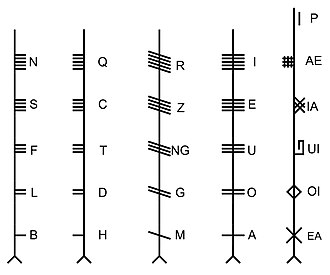Katherine Forsyth | |
|---|---|
| Academic background | |
| Alma mater | University of Cambridge Harvard University |
| Academic work | |
| Discipline | history |
| Sub-discipline | history and culture of Celtic-speaking peoples |

Katherine S. Forsyth is a Scottish historian who specializes in the history and culture of Celtic-speaking peoples during the 1st millennium AD,in particular the Picts.
Contents
Forsyth is currently a professor in Celtic and Gaelic at the University of Glasgow in Scotland. She graduated from the University of Cambridge and Harvard University. [1]
Forsyth is an expert in the Ogham script,and has provided readings for a number of Ogham inscriptions,including the Buckquoy spindle-whorl and the Lunnasting stone. [2] Forsyth has reinterpreted a number of Pictish Ogham stone inscriptions that were previously thought to be written in an unknown pre-Indo-European language,and has argued that the Picts spoke a Brythonic language. [3]